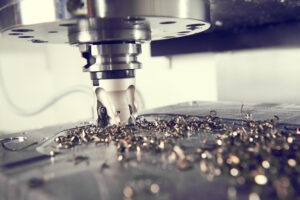Intro
In order to get the best results, you need to use the right machining operation. However, there are so many options to consider — where are you supposed to start? In this guide, we’ll explain 7 of the more common types of machining operations. You’ll learn what they are, how they work, and when to use them in a project.
What Is Machining?
The term “machining” is incredibly general. It broadly refers to a method of removing material from a big piece of stock material until the desired shape, features, and functionality is achieved.
Another key part of machining revolves around automation and tooling. Using a chisel and hammer to carve a piece of wood isn’t considered machining, but doing the same carving with a CNC milling machine is considered machining.
You would machine a part when you need to change the shape of the stock material in order to use it. A bar of metal isn’t so useful, but machining it into a sprocket completely changes its usability.
Explanation of 7 Types of Machining Operations
Since machining is such a broad term, let’s look at 7 specific examples of machining operations. We’ll outline what it is, how it works, and when you might use each operation.
Milling
Milling is one of the more common cutting options in traditional machining. It involves a quickly-rotating cutter attached to a 2-axis, 3-axis, 4-axis, or 5-axis gantry. The head of the milling machine will move around while the stock material is firmly fastened directly underneath the head.
You can use a milling machine to smooth or flatten faces, create internal features, shape the exterior of a part, achieve precise overall dimensions, and make relatively complex parts.
The tolerances can be very tight if you use a precision machine shop’s milling machines.
There are a number of different tools that can be used within a milling machine to achieve the specs of your part.

Turning
A turning operation works a lot like a milling machine, but it’s specifically for round parts. CNC lathes are an example of turning machines where the cutting tool is held in a certain position and the circular raw material is quickly spun.
The cutting tool typically moves in the X and Y direction, and cuts are done symmetrically around the central axis of the part.
This process allows you to cut non-standard holes with very tight tolerances. You can also change the internal and exterior dimensions of cylindrical parts. Lathes have high repeatability and reliability, so we can create hundreds of parts that are dimensionally identical.
Grinding
If you want to change the surface finish of a part, you might use a grinding operation. The two reasons to use a grinder are to either get very precise hole dimensions, or change the surface roughness of a part.
Grinding can also be used as a post-processing step like lapping, honing, and finishing. This can create very smooth finishes on flat surfaces or cylindrical shapes alike. A common example of grinding is a bench grinder that you might have in your workshop or garage.
Drilling
Drilling is a machining operation that most people are familiar with. In our machine shop, we use standing drill presses, but you might be more familiar with electric drill drivers like a DeWalt. In fact, the exact same process is happening with both options.
The difference is that our standing drill press can work on bigger parts with more repeatability and precision. Both tools use a drill bit to cut specific holes into solid material. The holes are unthreaded, but a tap can be used to thread the holes as well.
Drill presses are reserved for making nominally-sized holes, like 1/4, 3/8, 3/16, and so on. If you want a non-nominal size, you will need to use a reaming or boring attachment, typically on a CNC milling machine.
Sawing
For anyone in construction, sawing is probably your best friend. This process is used to make rough cuts in a machine shop — in other words, we would use a horizontal bandsaw to cut metal parts into roughly the correct overall length before sending that chunk of metal to a milling machine.
Sawing is a quick process that has relatively low precision, so it isn’t used to make final cuts on any metal parts.
However, it’s a lot faster than doing a cut with a CNC milling machine. What could be sawed in 1 minute might take upwards of an hour to fully cut on a milling machine.
Planing
When you have a large surface that you need to flatten further, you might turn to a planer. Planing can be used as a finishing step to get a smoother part or create a precise overall thickness.
A long enough planing tool can plane a number of smaller parts at the same time, saving time and money on each project.
Laser Cutting
Industrial-grade laser cutters use lasers to cut through and engrave pieces of metal or plastic. Although it’s not a traditional machining operation, it’s one of the most common options for sheet metal parts. A laser cutter can create external and internal cuts within minutes. The accuracy is incredibly high, and the setup time is relatively low.
The result? A precise way to get custom sheet metal parts with very fast turnarounds. For smaller parts, we can create dozens of parts from a single cutting operation.
Conclusion
As you can see, each machining operation serves a very specific function. At Rapid Axis, we offer all of these machining operations and much more. Allow us to be your one-stop shop for all of your machining, finishing, and manufacturing needs. Get a free quote today.

